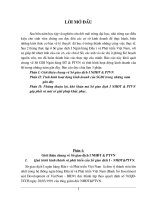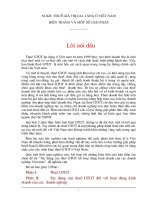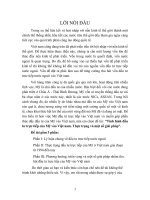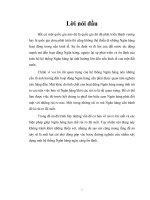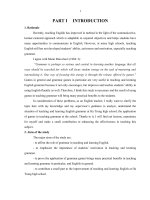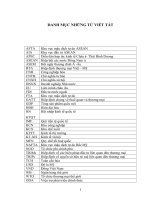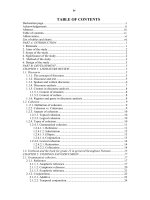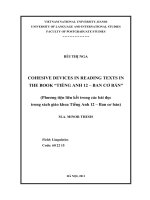Những khó khăn trong dạy ngữ pháp trong các tiết Language focus theo sách giáo khoa tiếng Anh 12 ở trường THPT Việt Nam - Ba Lan và một số giải pháp
Bạn đang xem bản rút gọn của tài liệu. Xem và tải ngay bản đầy đủ của tài liệu tại đây (1.36 MB, 68 trang )
h
VIETNAM NATIONAL UNIVERSITY-HANOI
University of LANGUAGES and International studies
FACULTY OF POST- GRADUATE STUDIES
*************
NGUYEN THU YEN
Challenges in Teaching Grammar in the “Language Focus Periods”
with the New English Textbook TiÕng Anh 12 at Viet-Ba High School
and Recommendations
(Những khó khăn trong dạy ngữ pháp trong c¸c tiÕt
“Language Focus” theo s¸ch gi¸o khoa TiÕng Anh 12
ở tr-ờng THPT Việt nam-Ba Lan và một số giảI ph¸p)
M.A. MINOR PROGRAMME THESIS
FIELD: ENGLISH METHODOLOGY
CODE: 60.14.10
HANOI – 2010
VIETNAM NATIONAL UNIVERSITY-HANOI
University of LANGUAGES and International studies
FACULTY OF POST- GRADUATE STUDIES
*************
NGUYEN THU YEN
Challenges in Teaching Grammar in the “Language Focus Periods”
with the New English Textbook TiÕng Anh 12 at Viet-Ba High School
and Recommendations
(Những khó khăn trong dạy ngữ pháp trong c¸c tiÕt
“Language Focus” theo s¸ch gi¸o khoa TiÕng Anh 12
ở tr-ờng THPT Việt nam-Ba Lan và một số giảI ph¸p)
M.A. MINOR PROGRAMME THESIS
FIELD: ENGLISH METHODOLOGY
CODE: 60.14.10
SUPERVISOR: Khoa Anh Viet
HANOI – 2010
iv
TABLE OF CONTENT
DECLARATION……………………………………………………
ACKNOWLEDGEMENT………………………………………………….
ABSTRACT…………………………………………………………………..
TABLES OF CONTENTS………………………………………………...
LIST OF ABBREVIATIONS……………………………………………..
LIST OF CHARTS AND TABLES………………………………………
Chapter 1: INTRODUCTION………………………………………………….1
1.1. RATIONALE………………………………………………….……..1
1.2. AIMS OF THE STUDY……………………………………………..2
1.3. RESEARCH QUESTIONS………………………………………….2
1.4. RESEARCH METHODOLOGY……………………………………2
1.5. SCOPE OF THE STUDY……………………………………………3
1.6 . DESIGN OF THE STUDY………………………………………….3
Chapter 2: DEVELOPMENT………………………………………………....4
2.1. LITERATURE REVIEW…………………………………………4
2.1.1. Definitions of Grammar…………………………………………………...4
2.1.1.1. Grammar as rules………………………………………………...5
2.1.1.2. Grammar as meaning……………………………………………..6
2.1.1.3. Grammar as discourse…………………………………………….7
2.1.2. The role of Grammar in foreign language teaching……………….8
2.1.2.1. Pro-grammar perspectives………………………………………….9
2.1.2.2. Anti-grammar perspectives………………………………………..10
v
2.1.3. Methods commonly used in teaching grammar…………………..11
2.1.3.1. Explicit grammar teaching…………………………………………11
2.1.3.2. Implicit grammar teaching………………………………………….12
2.1.4. Grammar teaching in the light of CLT……………………………13
2.1.4.1. Definition of CLT…………………………………………………………..…..13
2.1.4.2. Teaching grammar in the light of the communicative approach...15
2.1.5. Related studies……………………………………………………..16
2.2. RESEARCH METHODOLOGY………………………………………...18
2.2.1. Introduction……………………………………………………………18
2.2.2. Research questions:…………………………………………………....20
a. What do the teachers at Viet-Ba High school perceive of the problems in
teaching Grammar to 12th form students in the “Language Focus periods”?
b. What should be done to overcome those problems at Viet-Ba High
school?
2.2.3. The participants of the study………………………………………….20
2.2.3.1. The teachers and their teaching situations and conditions…….….20
2.2.3.2. The participants of the study…………………………………………...21
2.2.4. The instruments……………………………………………………….21
2.2.4.1. Questionnaire……………………………………………………………..21
2.2.4.2. Classroom observation………………………………………………….21
2.2.4.3. The interview…………………………………………………………..…23
2.2.4.4. Procedure……………………………………………………………….…23
2.3: DATA ANALYSIS AND DISCUSSION…………………………………25
2.3.1. Results and discussion from the questionnaire………………………..25
2.3.2. The result and discussion from the observation ………………………31
2.3.3. The result and discussion from the interviews………………………...32
vi
2.4. FINDINGS AND SOME POSSILE SOLUTIONS FOR BETTER
TEACHING ENGLISH GRAMMAR IN THE “LANGUAGE FOCUS” TO 12TH
FORM STUDENTS AT VIET-BA HIGH SCHOOL…………………………34
2.4.1. Summaries of the major findings……………………………………...34
2.4.2. Recommendations……………………………………………………..37
2.4.3. Limitation of the study………………………………………………...42
2.4.4. Suggestions for further research…………………………………….…43
Chapter 3: CONCLUSION……………………………………………... 44
REFERENCE ………………………………………………………………… I
APPENDIX………………………………………………………………..……IV
Appendix 1: Questionnaire for teachers …………………………………………………………V
Appendix 2: Interview questions for teachers …………………………………………………………………………VIII
Appendix 3: Extracted transcription of the interview……………………….…………………..IX
Appendix 4: Observation 1…………………………………………………………………………………………………………XII
Appendix 5: Observation 2………………………………………………………………….…XVI
LIST OF ABBREVIATIONS
CLT
Communicative Language Teaching
EFL
English as Foreign Language
ESL
English as Second Language
vi
2.4. FINDINGS AND SOME POSSILE SOLUTIONS FOR BETTER
TEACHING ENGLISH GRAMMAR IN THE “LANGUAGE FOCUS” TO 12TH
FORM STUDENTS AT VIET-BA HIGH SCHOOL…………………………34
2.4.1. Summaries of the major findings……………………………………...34
2.4.2. Recommendations……………………………………………………..37
2.4.3. Limitation of the study………………………………………………...42
2.4.4. Suggestions for further research…………………………………….…43
Chapter 3: CONCLUSION……………………………………………... 44
REFERENCE ………………………………………………………………… I
APPENDIX………………………………………………………………..……IV
Appendix 1: Questionnaire for teachers …………………………………………………………V
Appendix 2: Interview questions for teachers …………………………………………………………………………VIII
Appendix 3: Extracted transcription of the interview……………………….…………………..IX
Appendix 4: Observation 1…………………………………………………………………………………………………………XII
Appendix 5: Observation 2………………………………………………………………….…XVI
LIST OF ABBREVIATIONS
CLT
Communicative Language Teaching
EFL
English as Foreign Language
ESL
English as Second Language
vii
MOET
OHP
SLA
Ministry of Education and Training
Overhead projector
Second Language Acquisition
LIST OF CHARTS AND TABLES
Page
Chart 1: Teachers’ attitude toward grammar teaching………………………………………….25
Chart 2: Teachers’ awareness of the role of grammar teaching………………………………...25
Table 1: Techniques used to teach a new grammar item………………………………………..26
Chart 3: The ways to teach a new grammar item……………………………………………….27
viii
Chart 4: Teachers’ awareness of difficulties in grammar teaching……………………………..28
Chart 5: Teachers’ suggestions to solve these problems………………………………………..29
-1-
Chapter I: INTRODUCTION
1.1
RATIONALE:
In Vietnam English has played an important part in the development of technology and
business nowadays. It is considered as the language for international communication and as an
instrument for receiving grants and aid. Teaching and learning English have become more and
more necessary and important because of the international integration process. It is offered as a
compulsory subject in the curriculum as well as the national high school examinations. One of
the main tasks assigned to English teaching at school is that of training students to be
communicatively competent. Moreover, since Vietnam entered WTO, there has been a growing
awareness of the importance of and need for spoken English. Especially, since school year 20082009 a new educational reform has been carried out, a new National reform Curriculum has been
followed in all schools in Vietnam. The new textbooks “English 10,11,12” have marked real
renovation in English teaching and learning from the traditional approach –Grammar translation
method to communicative approach .
In Vietnam, foreign language teaching in general and English language teaching in
particular is said to be grammar-focused. For many English teachers and students teaching
English means teaching grammar. There are many good reasons for this. The first reason for this
is the aim of the national examinations whose sole objectives is to measure candidates‟ linguistic
or grammatical competence in written form. Therefore, the teaching of English in secondary
schools is still directed towards preparing students for such a sort of examinations. Furthermore,
without learning grammar, students can not communicate well, to put it another way, the
language they produce is considered ungrammatical and unacceptable.
However, how to teach and learn grammar effectively has been in question up to now, and
has been considered as a challenge for many Vietnamese teachers of English in secondary
schools. Both teachers and students in schools are always faced up with many difficulties.
At Viet-Ba High school, like at many other high schools in Vietnam, English has been a
compulsory subject in secondary curriculum for many years. I myself and other English teachers
here are aware of the importance of English grammar teaching. For me, finding challenges in
teaching and learning Grammar in the “Language Focus” periods is one of the ways to deal with
grammar more effectively in the secondary school classrooms. And this would be of great help to
myself as well as to other teachers. This is also the reason why my thesis is entitled: “Challenges
-2-
in Teaching Grammar in the “Language Focus periods” with the New English Textbook
Tiếng Anh 12 at Viet-Ba High School and some Possible Solutions”
1.2 AIMS OF THE STUDY:
For the reasons mentioned above, the specific aims of the study, accordingly, are:
To investigate into the challenges many teachers at Viet-Ba High school encountered in
teaching grammar in the “Language Focus” periods with the New English Textbook
Tiếng Anh 12.
To find out some possible solutions including a variety of techniques and activities to
achieve the effectiveness in teaching grammar and in order to make grammar teaching
more communicative.
1.3 RESEARCH QUESTIONS:
1. What do the teachers at Viet-Ba High school perceive of the problems in teaching Grammar
to 12th form students in the “Language Focus periods”?
2. What should be done to overcome those problems at Viet-Ba High school?
1.4 RESEARCH METHODOLOGY:
On the completion of the study, some advantages of both qualitative and quantitative methods
were taken as the main research tools in order to seek answers for the research questions.
To begin with, an extensive review of literature was conducted, critically examining
grammar‟s role in language teaching and learning, some common methods used in teaching
grammar and their influences on teaching and learning grammar.
Sources of data were collected, involving the teachers in Viet-Ba High school in order to
achieve the aims of the study.
Questionnaires: Conducting a survey questionnaire to investigate teachers‟ evaluative
comments and their attitudes towards teaching English grammar to 12 grade as well as
their perceived challenges.
Observation: Observing some classes to investigate how grammar was approached in the
classroom by 2 different teachers.
Interview: Interviewing 2 grade 12th teachers to get better insights into the research
questions.
Data collected from the questionnaires were triangulated with classroom observation and
interview. All these were done at Viet-Ba High school in Hanoi.
-3-
1.5 SCOPE OF THE STUDY:
The study is limited to the area of teaching grammar in language focus periods in 12 th form
at Viet-Ba High school. The minor thesis is designed to deal with the challenges which teachers
at Viet-Ba High school encounter during the process of teaching grammar and some possible
solutions will be introduced with the aim at making grammar lessons more communicative. I
would like to do the research with only 6 teachers teaching 12th form with their classes in order to
find out the most effective way to teach grammar successfully.
1.6 DESIGN OF THE STUDY:
The study consists of 3 main parts, which are presented as follows:
Chapter 1. Introduction. This chapter provides an overview of the study with specific
reference to the rationale, the aims, the methods and the scope of the study.
Chapter 2. Development. This chapter is divided into four main parts
2.1. LITERATURE REVIEW. This part explores the theoretical background for the
thesis. This part mentions to four main points related to English grammar: Definitions of
grammar; the role of Grammar in foreign language teaching; Methods commonly used in
teaching grammar; Grammar teaching in the light of CLT.
2.2. RESEARCH METHODOLOGY. This part presents the research questions of the
study, the subjects of the study, and the instruments used to collect the data.
2.3. DATA ANALYSIS AND DISCUSSION. This part explores a detailed description of data
analysis and a discussion of the findings of the study.
2.4. FINDINGS AND SOME POSSIBLE SOLUTIONS FOR BETTER TEACHING ENGLISH
GRAMMAR in the “Language Focus” TO 12TH FORM STUDENTS AT VIET-BA HIGH SCHOOL. This
part presents the summary of the major findings including some possible problems in teaching
English grammar encountered by teachers in Vietnam in general and at Viet-Ba High school in
particular. Especially, some recommendations proposed for the administrators and for the
teachers teaching grammar in the upper secondary school are mentioned in this part. Finally, the
limitations of the study and some suggestions for further research are presented.
Chapter 3.Conclusion
-4-
Chapter 2. DEVELOPMENT
2.1. LITERATURE REVIEW
2.1.1. Definitions of Grammar
It is not easy to define exactly what grammar is. Up to now many linguistics and
grammarians have given out their different definitions of grammar. The most important is how
the term is being used in each particular context. There are so many definitions of grammar but in
this study I would like to list out some of the following ones.
The first definition of grammar I want to mention is by “The Longman Dictionary of
Contemporary English”. It defines grammar as the rules by which words change their forms and
are combined into sentences.
“There are two basic elements in this definition: the rules of grammar; and the study and
practice of the rules. The rules of grammar are about how words change and how they are put
together into sentences. The knowledge of grammar also tells the learner what to do if he wants to
put the some phrase into the sentence. Grammar should be called the way in which words change
themselves and group together to make sentences”. (Harmer, 1991, p. 1)
Here is a working definition! Grammar is essentially about the systems and patterns we use
to select and combine words…By studying grammar we come to recognize the structure and
regularity which is the foundation of language and we gain the tools to talk about the language
system. (Burns, 1999, pp. 4-5)
Thornbury (2001, p. 2) even introduces the term “to grammar” implying that it is a
process that we do as we speak and makes the analogy between product and process in terms of
something finished like an omelette and the process of making it, saying that it is impossible, if
you only see or taste the omelette, to be able to actually make it.
Ur (1998, p. 1) has given a broader definition to grammar, which is clear and easy to
understand: “Grammar may be roughly defined as the way a language manipulates and combines
words (or bits of words) in order to form longer units of meaning”.
Bastone (1994) defines grammar is multi-dimensional: grammar is a formal mechanism, a
functional system from signaling meanings, or a dynamic resource which both users and learners
call on in different ways at different times.
Cristal (2004) gives more ideas of grammar as:
-5-
“Grammar is the structural foundation of our ability to express ourselves. The more we are
aware of how it works, the more we can monitor the meaning and effectiveness of the way we
and others use language”.
In this definition, he emphasizes the importance of grammar. For him, grammar can help
foster precision, detect ambiguity, and exploit the richness of expression available in English.
And it can help everyone--not only teachers of English, but also teachers of anything, for all
teaching is ultimately a matter of getting to grips with meaning.
Whatever grammar may be defined, it belongs to one of the aspects exploited by the
linguistics such as grammar as social function, grammar as discourse, etc. This has influence on
the way to teach and select materials to teach grammar in the light of CLT. Being a teacher of
English, to support my teaching I have chosen three aspects of grammar below for my discussion.
2.1.1.1. Grammar as rules
With regard to rules, Swain (1985) coins the third category of rule: pedagogic language rules.
“By „pedagogic rules” I mean rules which are designed to help foreign-language learners understand
particular aspects of the languages they are studying (whether these rules are addressed directly to the
learners, or to teachers and materials writers who are expected to pass on the rules to the learners in
one form or another, is immaterial).‟
Here he refers to a collection of such rules, unoriginally, as a “pedagogic grammar”. This
term can also reasonably be applied to a collection of rules designed for students who are
learning about the structure of their own language, and much of what shall I have to say is
relevant to mother-tongue language instruction
Grammar and rules are the things synonymous in the minds of many teachers and learners. It
is obviously true because mentioning to what grammar is, many linguistics and grammarians use
the words “rules” in their definitions.
As defined in dictionary, grammar is the system of rules governing the conventional
arrangement and relationship of words in a sentence. Technically, grammar refers to sentencelevel rules only, and not to rules governing the relationship among sentences, which we refer to
as discourse rules.
A typical definition of grammar would be 'the rules by which words change their form and
are combined into sentences' or 'a book which teaches these rules' (dictionary definitions) but for
the purposes of learning a language these definition are not enough.
-6-
As Bastone (1994, p. 5) divides grammar into product: the component parts or rules that
make up the language, and process: the ways in which grammar is deployed from moment to
moment in communication. While of no doubt the rules are important to the learner, simply
knowing them is a far cry from being able to formulate or interpret complicated utterances in the
rush of real-time communication.
Crystal (2006) also mentions to the rules defining grammar as: “Grammar is the study of
all the contrasts of meaning that it is possible to make within sentences. The 'rules' of grammar
tell us how. By one count, there are some 3,500 such rules in English”
According to Fromkin et al (1990, p. 12)
“The sounds and sound patterns, the basic units of meaning such as words and the rules to
combine them to form new sentences constitute the grammar of a language. These rules are
internalized and subconsciously learned by native speakers”.
In his point of view, grammar represents one's linguistic competence. He also explains
grammar includes many aspects of linguistic knowledge: the sound system (phonology), the
system of meaning (semantics), the rules of word formation (morphology), the rules of sentence
formation
(syntax),
and
the
vocabulary
of
words
(lexicon).
2.1.1.2. Grammar as meaning
Organizational competence is necessary for communication to take place, but not sufficient
to account for all production and reception in language. As Larsen-Freeman
pointed out,
grammar is one of three dimensions of language that are interconnected. According to him
grammar gives us the form or the structures of language, but those forms are literally meaningless
without a second dimension, that of semantics (meaning), and a third dimension, pragmatics. In
other words, grammar tells us how to construct a sentence; discourse rules tell us how to string
those sentences together. Semantics tells us something about the meaning(s) of words and strings
of words. (Larsen-Freeman, 1991)
Since the early days of the Communicative Approach, language teachers have been told
that they have to pay attention to two kinds of meaning: the “semantic” meanings of words and
structures which can be found in dictionaries and grammars, and the “pragmatic” values which
these linguistic elements take on when they are used in communication. In an influential paper
published in the early 1970s Hymes, the sociolinguist put forward the view that “communicative
competence” involves knowing not only dictionary/grammar meaning, but also the rules which
-7-
determine the appropriacy or otherwise of utterances in context. This line of thought was
welcomed for several reasons. Language teachers at the time were dissatisfied, as language
teachers usually are, with their learners‟ inability to convert their knowledge of linguistic forms
into successful language use, and the idea that they could solve the problem by teaching
something called „communicative competence‟ was an attractive one. So Hymes‟ pronouncement
that there are “rules of use without which the rules of grammar would be useless” (Hymes, 1971,
p. 278) became something of a mantra for the applied linguists of the time.
One of the major reasons for questioning the adequacy of grammatical syllabuses lies in
the fact that even when we have described the grammatical (and lexical) meaning of a sentence,
we have not accounted for the way it is used as an utterance. Since those things that are not
conveyed by the grammar are also understood, they too must be governed by „rules‟ which are
known to both speaker and hearer. People who speak the same language share not so much a
grammatical competence as a communicative competence. According to Wilkins (1976, pp. 10–
11), looked at in foreign language teaching terms, this means that the learner has to learn rules of
communication as well as rules of grammar.
Despite the difficulty of clarifying what exactly might be meant by teaching “rules of use”
or “rules of communication” (Swan, 1985), the notion that teachers and learners need to concern
themselves with two levels of meaning has remained prominent in pedagogic thought and
writing. Celce-Murcia, M., & Larsen-Freeman, D. (1999, p. 4), in a widely-used course on
pedagogic grammar, explain that “Grammatical structures not only have a morphosyntactic form,
they are also used to express meaning (semantics) in context-appropriate use (pragmatics)”.
Ellis (2005), discussing the need for learners to focus on meaning, similarly distinguishes
two senses of the term: semantic and pragmatic.
To sum up, according to the grammar-as-meaning view, grammar is a “process for making
a speaker or writer‟s meaning clear when contextual information is lacking” (ThornBury, 1999,
p. 4). Learners need to learn not only what forms are possible, but what particular form will
express their particular meanings. From this perspective, grammar is a tool for making meaning.
2.1.1.3. Grammar as discourse
Grammatical competence is a major component of communicative competence.
Organizational competence is an intricate, complex array of rules, some of which govern the
sentence (grammar), while others govern how we string sentences together (discourse).
-8-
Discourse analysis begun to influence how English grammar is taught to non-native
speakers of English over the past years. Research that is more recent is now concluding that we
should teach grammar on the basis of discourse. Canale & Swain (1980) claims that grammar not
only consists of rules governing form; but also grammatical knowledge consists of knowing
which knows when to use the forms to convey meanings that match our intentions in particular
contexts. Discourse analysis is concerned with the study of the relationship between language and
the contexts in which it is used (McCarthy, 1991). A discourse-oriented approach would suggest
not only a greater emphasis on contexts larger than the sentence, but also a reassessment of
priorities in terms of what is taught about such things as word order, articles, ellipsis, tense and
aspect and some of the other categories (McCarthy, 1991).
In the EFL classroom, grammar is often taught at the level of sentence. And such problems
are often met that the students can‟t relate the grammar with what they want to convey in spoken
or written discourse. Furthermore, a sentenced-based view of grammar is inconsistent with the
notion of grammar competence (Celce-Murcia, 2000). Hence, discourse-based approaches in
grammar teaching would be strongly advocated and carried out.
2.1.2. The role of Grammar in foreign language teaching
In ESL and EFL grammar teaching methods are debatable. Some see grammar as the
backbone of languages and learners should be presented with explicit grammar courses. Others,
however, think that knowing the grammar doesn‟t necessarily lead to language mastery. They
contend that focusing on explicit grammar teaching produces unsuccessful language users.
What is the role of grammar in language teaching?
This is a question which has been asked by several second language researchers and
teachers over the past few years (Brown, 1994; Celce-Murcia, 1991; Larsen-Freeman, 1991;
Nunan, 1994). Historically, grammar has played a central role in language teaching often being
the only activity in language classrooms (Brown, 1994). Celce-Murcia (1991, p. 460) points out
that:
“[p]rior to 1967 and for several years thereafter, however, no one challenged the centrality of
grammar either as content for language teaching or as the organizing principle for curriculum or
materials development”
The grammar translation approach, the audio-lingual approach, the cognitive code approach,
the comprehension approach and the communicative approach all view the role that grammar
should play in language teaching with slight variations. Very early in the days of the
-9-
communicative competence movement, Canale & Swain (1980) proposed that grammatical
competence was an integral part of communicative competence. Some language teachers moving
into the communicative era may have reacted too quickly in assuming that grammar was not a
significant part of language teaching and thus ignored its role in the classroom. Below I will
examine some arguments for and against grammar.
2.1.2.1. Pro-grammar perspectives
It is obvious that the definitions of grammar make us clear that grammar consists of certain
rules, the system of rules governing the conventional arrangement and relationship of words in a
sentence by which we can communicate with each other. The teaching of grammar has been the
focus of language teachers and learners for many years. The main goal of grammar teaching is to
enable learners to achieve linguistic competence; learners use grammar as a tool or resource for
comprehension, and creation of oral and written discourse efficiently, effectively, and
appropriately depending on the situation.
Most grammarians give strong support to grammar teaching. In other words, teaching
grammar plays an important role in foreign language teaching and learning.
Technically, grammar refers to sentence-level rules only, and not to rules governing the
relationship among sentences, which we refer to as discourse rules. Grammatical competence is a
major component of communicative competence. Organizational competence is an intricate,
complex array of rules, some of which govern the sentence (grammar), while others govern how
we string sentences together (discourse).
Organizational competence is necessary for communication to take place, but not sufficient
to account for all production and reception in language. As Larsen-Freeman pointed out,
grammar is one of three dimensions of language that are interconnected. According to him,
grammar gives us the form or the structures of language, but those forms are literally meaningless
without a second dimension, that of semantics (meaning), and a third dimension, pragmatics. In
other words, grammar tells us how to construct a sentence; discourse rules tell us how to string
those sentences together. Semantics tells us something about the meaning(s) of words and strings
of words. (Larsen-Freeman, 1991). It is important to grasp the significance of the
interconnectedness of all three dimensions: no one dimension is sufficient. So, no one can say
that grammar is irrelevant, or that grammar is no longer needed in a CLT framework.
-10-
In favor of the importance of grammar, Burns (1999, pp. 4-5) affirmed that grammar is
essentially about the systems and patterns we use to select and combine word. By studying
grammar we come to recognize the structure and regularity which is the foundation of language
and we gain the tools to talk about the language system.
Ur (1998, p. 4) stressed the importance of grammar in language learning and teaching. He
stated “a knowledge-implicit or explicit – of grammatical rules is essential for the mastery of a
language: you can no use words unless you know how they should be put together”
In short, how important grammar is assumed obviously has an impact on the foreign
language teaching and learning.
2.1.2.2. Anti-grammar perspectives
In recent years, the role of grammar in language teaching and learning has received
different interpretation. Although most of linguistics and grammarians appreciate the role of
grammar, there are still some people express different views against the teaching grammar, want
to lessen its role.
According to Brumfit and Johnson (1979, p. 165) “The study of grammar is neither
necessary nor sufficient for learning a language”
As for Thornbury (1999), grammar is a process of making a speaker‟s or writer‟s meaning
clear when there is a lack of contextual information. Moreover, grammar means the relationship
between three things: grammar, words, and contexts. It means it is necessary for students only to
learn basic and fixed forms and particular forms so that they can express particular meanings.
And Ur (1998, p. 4) gives a controversial question:
“Whether should we teach grammar or not? Do we have to have grammar exercises? Isn‟t it
better for students to absorb the rules intuitively through communicative activities than to be taught
through special exercises?”
To sum up, although there exist controversies about the role of grammar in language
teaching and learning, as a teacher of English at school, I can say that it is important and essential
to teach grammar in universities and especially in secondary schools. There are some reasons for
this. Firstly, the teaching of grammar provides students with opportunities to use English in a
variety of realistic situations to learn to communicate effectively. Secondly, without being taught
grammar teaching students can‟t improve their grammar competence in a suitable environment.
-11-
Especially, without grammatical knowledge students must have less opportunities to pass the
exams at school or university because for them English is compulsory subject.
2.1.3. Methods commonly used in teaching grammar
Over the past few decades, grammar instruction has long been a controversial issue in the
field of second language and foreign language acquisition. It has been of great interest to
researchers and teachers that whether grammar should be taught and how to teach grammar if it is
necessary. Focused on these two key questions, grammar instruction has undergone its ups and
downs through many linguistic schools and pedagogical approaches, in the process of which the
necessity of grammar instruction is no longer the focus, and the explicit-implicit dimension in
grammar teaching has received more attention. Two major approaches to teaching grammar have
been identified in prior literature mainly the “explicit” grammar teaching which involves
teaching formal rules of grammar, and the “implicit” grammar teaching approach which focuses
on teaching grammar through content. Many empirical studies have investigated that which
method is better for grammar teaching, explicit or implicit (Scott, 1989) and whether there is an
interface between explicit grammatical knowledge and implicit grammatical. There are good
theoretical reasons to place matters of implicit and explicit issues, including implicit and explicit
knowledge, learning and instruction, high on the agenda for Second Language Acquisition (SLA)
research.
2.1.3.1. Explicit grammar teaching
Despite the development of these various instruction approaches to SLA, there may be no
single approach to SLA appropriately applied in all contexts to the varying types of learners that
L2 teachers face. Instead, at the core of these different instruction approaches to SLA, two key
contrasting and independent concepts have been commonly involved: explicit and implicit. While
these two types of approaches have raised a number of controversial issues regarding the effects
of SLA, a number of recent studies have taken stronger views about the advantages of explicit
instruction approaches to SLA of L2 grammar especially in the EFL situation due to the features
and merits of the explicit approach.
With regard to advantages of explicit grammar teaching, a number of researchers have
investigated many obvious advantages and crucial functions of conscious learning in SLA.
Krashen (1982), in his Monitor Theory, stated that „learned grammatical principles function to
edit or monitor language output that has been generated by acquired rules‟. It goes without saying
-12-
that an explicit approach can not only help learners draw more learners' attention and exploit
pedagogical grammar in this regard but also is fully and clearly expressed, defined or formulated,
and readily observable (Doughty & Williams, 1998) and also explicit grammar instruction can
solve problems with purely communicative driven approaches, and can provide three important
parts of the grammar lesson such as explicit grammar instruction preferably at the beginning of
the lesson, communicative activities containing many usages of the instructed form, and
summary activities to focus learners' attention on the grammar form they were instructed on and
then encountered communicatively. However, a problem with explicit grammar teaching is that
the teachers who focus on language forms presentation, explain the grammar rules and practice
through drilling hold a traditional view of language teaching. They equate language to grammar
mastery and accurate usage and create bored, disaffected students who can produce correct forms
on exercises and tests, but consistently make errors when they try to use the language in context.
In other words, students under this form of instruction know a lot about the language but they are
unable to use the language itself appropriately in contextualized situations- these students
consistently make errors when they try to use the language in context.
To summarize, explicit teaching begins very teacher-centered with little student responsibility
and ends with a goal of complete student independency with very little teacher involvement.
2.1.3.2. Implicit grammar teaching
In the early 20th century it is thought grammar should be studied by examining living
speech rather than by analyzing written documents. According to some linguists, by providing
grammar in context, in an implicit manner, they can expose students to substantial doses of
grammar study without alienating them to the learning of English or other foreign language. I
also agree with this implicit approach of teaching grammar. The principal manner in which I
accomplish this is by teaching short grammar-based sessions immediately followed by additional
function-based lessons in which the new grammar / structure is applied in context. For students,
implicit learning is “learning without conscious attention or awareness” (Brown, 2007, p. 291). In
addition, implicit learning occurs “without intention to learn and without awareness of what has
been learned” (Brown, 2007, p. 292).
From my teaching experience I believe that focus on grammar explanation and the
absence of any reference to meaning can be detrimental to language acquisition. Of course
grammar is the backbone of any language. Grammar knowledge can be helpful in producing
-13-
accurate forms of language and acts in monitoring its use. But, it is worthwhile noticing that one
can communicate more or less a message with vocabulary items alone while it is impossible to do
so using grammar alone. This shows that grammar alone doesn‟t make the language. What is
more, language use can be tremendously affected by conscious language usage as this may create
a stressful environment. So a balanced approach to grammar teaching takes into consideration
the appropriate use of language and doesn‟t reject the (conscious or unconscious) internalization
of the rules. Some of the major approaches that hold this view are the communicative approach,
the natural approach and the lexical approach.
In my own teaching at school, I find that there are many different ways to implement
implicit teaching methods into a classroom. The basic idea is that students are given examples of
a desired topic through any medium. Any kind of topic can be taught implicitly including:
grammar, vocabulary, culture, etc. Students should be aware of what the learning objective is.
Students are never taught the actual rules; they deduce their own form of rules based on the
examples given. For example: When presenting the use of the ending-s with verbs in the present
simple tense to students, I often carry out three stages:
Stage1: I give the students the following sentences and ask them to find the grammatical
pattern.
-
I go to school every day.
-
My mother works at the IBM company.
-
Water boils at 100C.
-
My friends play tennis with me.
-
They ride bicycle.
Stage 2: -the explanation stage: I tell the students the explicit grammatical rules of the
present simple tense with singular form, explain the rule of use of the ending-s.
Stage 3: Expression: I divide students into pairs and give them the task.
2.1.4. Grammar teaching in the light of CLT
2.1.4.1. Definition of CLT
Communicative language teaching (CLT) is an innovation in English language teaching
(ELT). CLT is a new teaching approach in Britain, having been introduced in the 1970s, and it
has become a popular approach in foreign language teaching since the 1980s. Many researchers
have helped to develop the theory and practice of CLT, among them Brumfit & Johnson (1979),
-14-
Hymes (1972), and Richards & Rodgers (1986), to name only a few. In CLT, students do not
simply learn the linguistic structures and grammar rules. They have to learn how to use the
language properly. There is a “strong” version and a “weak” version of the communicative
approach. „The weak version [that] has become more or less standard practice in the last ten
years, stresses the importance of providing learners with opportunities to use their English for
communicative purposes‟ (Richards & Rodgers, 1986).
Because the range of CLT is so wide, it is difficult to identify precisely whether a teacher
is using CLT. Many researchers have discussed “communication” and CLT. Widdowson (1990)
holds that language is used to achieve a communicative purpose. Littlewood (1981) also states
that language is used as a tool for communication. Two major points are expressed in the studies
of CLT. One is that language is learned to enable one to communicate. The other concerns the
curriculum objectives. Larsen-Freeman (1986) argues that, “the goal of the CLT is to help
learners become communicatively competent”. According to Richards & Rogers (1986) in order
to achieve this goal, learners need to develop communicative abilities, such as expression,
interpretation, and negotiation. In order to become a communicative speaker, learners not only
need to master the grammatical rules of a language but they also need to know how to use the
target language suitably in different situations. The teacher sets up a situation that students are
likely to encounter in real life. The real-life simulations change from day to day. Students‟
motivation to learn comes from their desire to communicate in meaningful ways about
meaningful topics.
Brown‟s presentation (1994, p. 245) of four interconnected characteristics could be used as
a definition of communicative language teaching (CLT):
a. The language teaching goals should contain all the components in communicative competence.
For example, learners, after they study the target language, should not only be able to listen to a
large part of the authentic speech utterances, speak relatively fluently in the target language and
make themselves understand; but also be able to read printed materials of average difficulty and
write relatively properly in the target language.
b. Learners should be engaged in the pragmatic, functional use of language for meaningful
purposes. Organizational competence is not the central focus but should be considered as a
facilitator to accomplish those purposes. This is because the emphasis of CLT is on real
-15-
communication, and in real communication, both the pragmatic, functional use of language
organizational competence cannot be lacking.
c. Fluency, at times, should take on more importance than accuracy in order to keep learners
meaningfully engaged in language use. Because CLT focuses on speaking the target language
with fluency and being understood by the listener, grammar teaching and structure of the
sentence are not as important as fluency. It is also important that teachers do not correct students
immediately when they are speaking.
d. Students should finally use the language productively and receptively, in understand contexts.
These three sides are the most important for using language and succeeding in real
communication.
2.1.4.2. Teaching grammar in the light of the communicative approach
Over the past several years, whether or not grammar should be taught explicitly or
implicitly has been a controversial issue. Extensive grammar research has shown that grammar
should be neglected in teaching English ever since communicative methodology appeared in the
late 1970s. It was claimed that language should be acquired through natural exposure, not
through formal instruction. However, recent research studies have demonstrated that grammar
instruction enables learners to attain high level of proficiency, both in accuracy and fluency. It
was claimed that the teacher should provide learners with authentic discourse samples to illustrate
all the contextually dependent grammatical rules (Ellis. 2002).
About Teaching Presentation in Grammar, Larsen-Freeman (2003) suggested that a
pedagogic grammar lesson should follow three parts: explicit grammar instruction,
communicative activities, and summary activities. At the beginning of the lesson, the teacher
gives students explicit grammar rules and explanation. Then, the teacher provides many
communicative activities that contain uses of the instructed form. Last, in the summary activities
section, students will pay more attention on the grammar form they have just studied and then
perform communicatively.
Here is a typical grammar class following CLT. In the class the teacher uses visual aids to
present the grammar structure to be taught. Students deduce the meaning, the form and the use of
it. The teacher checks students' understanding by asking yes/no questions focusing on form,
meaning and use. The teacher gets students to practice the structure through Repetition and
Substitution Drills. The teacher tries to provide maximum practice within a controlled but
-16-
realistic and contextualized framework and to build students' confidence in using the new
language. The teacher provides students with opportunities to use the new language in a freer and
more creative way. The teacher creates activities in which students can integrate new language
with the previously learnt language and apply what they have learnt in talking about their real life
activities. What makes this kind of lesson different from the traditional ones is that the teacher
tries to make the language used in the lesson real and true. The teacher creates real or close-toreal situations in which the language can be used. This will better enable students to
communicate in English not only in the classroom but also outside the classroom.
We should always consider why people learn a foreign language and what they do with it
when we teach a foreign language. Indeed, the reasons to learn a foreign language can vary and
we should always keep the learners 'needs in mind. People learn a language e.g. for their work,
out of interest or simply because it belongs to school syllabus
In brief, the requirement for a successful grammar lesson following CLT is that after
learning a certain grammatical structure, the students are able to use it in real life communication.
2.1.5. Related studies
The teaching of grammar has always been a central aspect of foreign language teaching. It
has been the focus of language teachers and learners for many years. Grammar is considered to
be an indispensable factor which helps people use its language to communicate successfully. The
importance of grammar in general and grammar teaching in particular has been highly
appreciated and has been the focus of many studies up to now. Now I can give some studies
related to my research.
The first study I want to mention is on the theme “Applying communicative approach to
grammar teaching and learning at Tran Phu gifted high school” by the author Pham Thi Mai
Anh in October, 2007. The attempts of this study are to find out the students‟ and teachers‟
attitudes as well as heir preferences to grammar teaching and learning towards the
communicative approach. Carrying out the study, the author hopes to find out how to teach and
learn grammar according to the communicative approach effectively and successfully.
Another research that is about grammar is named “Adapting materials for teaching
grammar in the light of CLT to first year students in electric power college” by Nguyen Thi
Thang in September, 2006. This study was conducted to seek the answers to the questions of
what techniques of adapting materials should be used to teach grammar to first year students at
-17-
EPC in the light of CLT. Through what the author has done, she believes the teachers should
know how to combine materials of traditional approach like gap-filling, tenses etc, with those of
CLT approach. In other words, they should know how to balance these materials to suit their
students‟ needs and interests.
“An investigation into Vietnamese upper secondary school students’ attitudes towards
grammar learning and teaching” was carried out by Nguyen Thi Minh Hue in June, 2004. The
aim of this study is to find out what attitudes Vietnamese upper secondary school students hold
towards grammar and grammar learning especially with their styles preferences in an attempt to
narrow the gap between teaching styles and learning styles as a goal of learner-centredness in
language education. Through this investigation, the author expects that a blend of both traditional
and communicative approaches to grammar could be a good solution to the question of grammar
teaching at the Vietnamese upper secondary school.
Being a teacher of English in a upper secondary school, I am aware of the importance of
grammar as well as of the grammar teaching in the process of teaching. How to teach grammar
effectively and successfully is always a big question not only to me but also to many other
teachers at my school, especially nowadays new textbooks used in all schools in our country
focus on not only grammar teaching but also on other skills in the light of CLT. The teaching of
grammar in “Language focus period” is always a challenge to every one. Teaching grammar, the
teachers encounter some certain difficulties in comparison with teaching other skills. Being aware
of this, I have decided to choose the topic on the teaching of grammar for my thesis with the aim
to find out the difficulties many teachers encounter when teaching grammar in “Language focus
periods” with the New English Textbook Tiếng Anh 12 and some possible solutions to these
problems. Furthermore, up to now there have been no studies on this topic carried out at Viet-Ba
High school, the school where I am teaching now. All these above mentioned reasons have
inspired me to conduct the study about “Challenges in Teaching Grammar in the “Language
Focus periods” with the New English Textbook Tiếng Anh 12 at Viet-Ba High School and
some Possible Solutions”. I hope this would be taken into consideration by the teachers at VietBa High school in particular and teachers of English in general to make the “Language focus”
periods more interesting and motivating to students.

